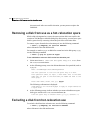
384 Administering hot-relocation
How hot-relocation works
Complete disk failure mail messages
If a disk fails completely and hot-relocation is enabled, the mail message lists
the disk that failed and all plexes that use the disk. For example, you can receive
mail as shown in this example display:
To: root
Subject: Volume Manager failures on host teal
Failures have been detected by the Veritas Volume Manager:
failed disks:
mydg02
failed plexes:
home-02
src-02
mkting-01
failing disks:
mydg02
This message shows that mydg02 was detached by a failure. When a disk is
detached, I/O cannot get to that disk. The plexes home-02, src-02, and
mkting-01 were also detached (probably because of the failure of the disk).
As described in “Partial disk failure mail messages” on page 383, the problem
can be a cabling error. If the problem is not a cabling error, replace the disk (see
“Removing and replacing disks” on page 112).
How space is chosen for relocation
A spare disk must be initialized and placed in a disk group as a spare before it
can be used for replacement purposes. If no disks have been designated as
spares when a failure occurs, VxVM automatically uses any available free space
in the disk group in which the failure occurs. If there is not enough spare disk
space, a combination of spare space and free space is used.
The free space used in hot-relocation must not have been excluded from
hot-relocation use. Disks can be excluded from hot-relocation use by using
vxdiskadm, vxedit or the Veritas Enterprise Administrator (VEA).
You can designate one or more disks as hot-relocation spares within each disk
group. Disks can be designated as spares by using vxdiskadm, vxedit, or the
VEA. Disks designated as spares do not participate in the free space model and
should not have storage space allocated on them.
When selecting space for relocation, hot-relocation preserves the redundancy
characteristics of the VxVM object to which the relocated subdisk belongs. For
example, hot-relocation ensures that subdisks from a failed plex are not
relocated to a disk containing a mirror of the failed plex. If redundancy cannot
be preserved using any available spare disks and/or free space, hot-relocation


















